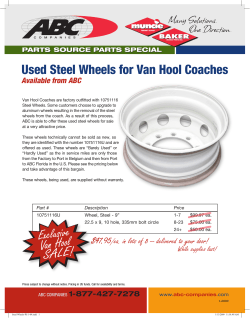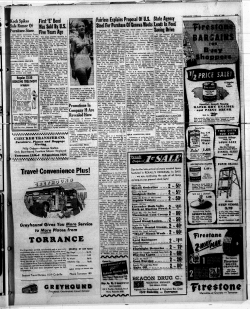
Iron and Steel MACT Environmental Quality Management, Inc. 1800 Carillon Boulevard
Iron and Steel MACT Environmental Quality Management, Inc. 1800 Carillon Boulevard Cincinnati, Ohio 45240 (800) 229-7495 Iron and Steel MACT z This MACT applies to all integrated iron and steel manufacturing facilities that are located at a major source of hazardous air pollutants (HAP) emissions. z A Major Source has the Potential to Emit: – 10 tons or more per year of any single HAP. Or – 25 tons or more per year of any combination of HAPs. z This MACT becomes effective on May 22, 2006, about 19 months from now. Iron and Steel MACT z This MACT contains specific requirements for: – Blast Furnace Casthouse – Basic Oxygen Process Furnace Shop including: z Each individual BOPF furnace z Hot metal transfer z Hot metal desulfurziation z Slag skimming z Ladle metallurgy – Sinter Plant Windbox Exhaust (Particulate & VOC) – Sinter Plant Discharge End – Sinter Plant Cooler Iron and Steel MACT Blast Furnaces Source Existing New Plants Plants Units Casthouse control device 0.01 0.003 gr/dscf Casthouse fugitives 20% 15% 6-minute average opacity. Iron and Steel MACT BOPF Shop Source Existing New Plants Plants Closed Hood BOPF 0.03 0.03 Primary Control Open Hood BOPF 0.02 0.01 Primary Control BOPF Secondary 0.01 0.0052 Control BOPF Roof Monitor 20% next (any shop opening) slide Units gr/dscf during primary O2 blow gr/dscf during steel production cycle gr/dscf 3-minute average opacity Iron and Steel MACT BOPF Shop Source Existing New Units Plants Plants New BOPF Roof Monitor with Bottom Blown BOPF (any shop opening) Last slide 10% 6-minute average opacity** New BOPF Roof Monitor with Top Blown BOPF (any shop opening) Last slide 10% 3-minute average opacity** **One average between 10% & 20% is allowed each cycle. Iron and Steel MACT BOPF Shop Source Existing Plants New Units Plants Hot metal transfer, 0.01 skimming & desulfurization operation 0.003 gr/dscf Ladle Metallurgy Operation 0.01 0.004 gr/dscf Iron and Steel MACT Sinter Plants (Particulate) Source Existing New Plants Plants 0.4 0.3 Windbox Exhaust Discharge End 0.02 0.01 Discharge End 20% 10% Cooler Stack 0.03 0.01 Units Lb/ton sinter product gr/dscf 6-minute average opacity gr/dscf Iron and Steel MACT Sinter Plants (VOC) z Maintain the 30-day rolling average oil content of the feedstock at or below 0.02% or z Maintain the 30-day rolling average of the VOC emissions from the windbox exhaust stream at or below 0.2 lb/ton of sinter. Iron and Steel MACT Capture & Control Devices z Each capture system must be operated at or above the lowest value or settings established for the operating limits in the operating and maintenance plan. z Each venturi scrubber must maintain the hourly average pressure drop and scrubber water flow at or above the minimum levels established during the initial performance test. Iron and Steel MACT Capture & Control Devices z Each electrostatic precipitator applied to emissions from a BOF must maintain the average opacity of emissions for each 6-minute period at or below the site-specific opacity value determined during the initial performance test. z For each applicable baghouse, a bag leak detector system must be installed, operated and maintained. Iron and Steel MACT Capture & Control Devices z Any control device other than a baghouse, venturi scrubber or ESP must establish operating parameters to maintain continuous compliance. Iron and Steel MACT Operation & Maintenance Requirements z Prepare and operate at all times according to a written Operation and Maintenance P lan for each capture system or control device used to comply with this MACT. Each plan must include: – Monthly inspections of the equipment that is important to the performance of the total capture system including z z z Pressure sensors Dampers Damper switches Iron and Steel MACT Operation & Maintenance Requirements – Inspections must include observations of the physical appearance of the equipment including: z z z Presence of holes in ductwork or hoods Flow constrictions caused by dents or accumulated dust in the ductwork Fan erosion – Plan must include a requirement to repair any defect or deficiency in the capture system before the next scheduled inspection. – Preventative maintenance for each control device, including a preventative maintenance schedule consistent with manufacturer’s instructions for routine and long-term maintenance. Iron and Steel MACT Operation & Maintenance Requirements – Operating limits for each capture system established as outlined below: z Select parameters appropriate for the capture system design that are representative and reliable indicators of performance of the system. At a minimum the parameters must indicate the level of ventilation draft and damper position settings for the capture system when operating to collect emissions, including revised settings for seasonal variations. Appropriate operating limit parameters for ventilation draft include: – Volumetric flow rate through each separately ducted hood – Total volumetric flow rate at the inlet to the control device – Fan motor amperage or static pressure Iron and Steel MACT Operation & Maintenance Requirements z z For each operating limit parameter, designate the value or setting for the parameter at which the capture system operates during the process operation. If your operation allows for more than one process to be operating simultaneously, designate the value or setting for the parameter for which the capture system operates during each possible configuration that you may operate. Include documentation to support the selection of the operating limits including a description of the method used to monitor the parameter and the data used to set the value or setting for each process configuration. Iron and Steel MACT Operation & Maintenance Requirements – Corrective action procedures for bag leak detection systems including: z z Initiate corrective action to determine the cause of a bag leak detection system alarm within one hour of the alarm. Initiate corrective action to correct the cause of a bag leak detection system alarm within 24 hours of the alarm and complete the corrective action as soon a practicable. Actions may include: – Inspecting the baghouse for air leaks, torn or broken bags or filter media, or any other condition that may cause an increase in emissions. – Sealing off defective bags or filter media. – Replacing defective bags or filter media or otherwise repairing the control device. Iron and Steel MACT Operation & Maintenance Requirements – Sealing off a defective baghouse compartment. – Cleaning the bag leak detection system probe, or otherwise repairing the bag leak detection system. – Shutting down the process producing the particulate emissions. – Procedures for determining and recording the daily sinter plant production rate in tons per hour. Iron and Steel MACT Performance Test Requirements z z z An initial performance test is required to demonstrate compliance with each emission and opacity limit that applies to the facility. An initial performance test is also required to demonstrate compliance with the sinter plant 30-day rolling average operating limit for the oil content of the sinter feedstock or the alternative limit for VOC emissions from the sinter plant windbox exhaust. Subsequent performance tests for PM are required at the midpoint and renewal of the Title V permit term (or every 2.5 years if there is no Title V permit. Iron and Steel MACT Performance Test Requirements z There are specific particulate performance testing requirements for: – Blast furnace casthouse control devices – Closed hood BOPF primary emission control devices – Open hood BOPF primary emission control devices – BOPF secondary emission control devices – BOPF ancillary operations – Sinter Plant windbox Iron and Steel MACT Performance Test Requirements z The opacity performance test for sinter plant discharge end and blast furnace casthouse consists of a minimum of 30 6minute block averages. For the blast furnace casthouse, opacity observations must be made during the period between the opening and plugging of the taphole. z For the BOPF shop (existing), opacity must be recorded for at least three complete steel production cycles. (A steel production cycle begins when the scrap is charged and ends 3 minutes after the slag is emptied from the vessel into the slag pot.) General Provisions z Individual MACT Standards are lengthy and seemingly complete—it is easy to overlook the requirements of the General Provisions, even though they are listed in a table in each MACT. Do Each of These Requirements Apply to Every Source? z No. Each MACT Standard is required to have a table indicating which sections apply. z In the Iron and Steel MACT, this is Table 4 to Subpart FFFFF. Many of these requirements are also repeated in that MACT. 63.10 Recordkeeping & Reporting z Occurrence and duration of each startup, shutdown, or malfunction of operation. z Occurrence and duration of each malfunction of the required air pollution control and monitoring equipment. More Recordkeeping z All required maintenance performed on the air pollution control and monitoring equipment. z Applicability determinations—If an owner determines that the source is in a source category regulated by a standard, but that the source is not subject to the standard, he or she must keep a record of the applicability determination and analysis. Ongoing Litigation z z This MACT is currently being litigated by several parties, including AISI and Sierra Club. The AISI draft settlement with EPA will amend, clarify, or revise eight specific issues. Examples: – Bag leak detectors will not be required for positive pressure baghouses without stacks. – COMs can be used in lieu of bag leak detectors with a 5% opacity (1-hr) action trigger level. – Vacuum degas operations will not be defined as ladle metallurgical operations under these rules. Ongoing Litigation z Examples, cont: – The 0.03 gr/dscf limit for sinter cooler stacks will be replaced with – – – – a 10% (6 minute average) opacity limit. The baghouse testing frequency will be changed from twice to once per permit term. Control device concentration limits, and corresponding parametric limits, will not apply to discharges inside buildings. A COM opacity measurement of 10% or greater (1-hr average) will trigger corrective action. Parametric monitoring may be established during any performance test that meets the corresponding emission limit. Other MACT’s z Don’t forget other recently promulgated MACT rules which may be applicable, such as: z z z Coke Pushing, Quenching, and Battery Stacks MACT: April 14, 2006 Boiler & Process Heaters MACT: September 13, 2007 There may be others as well.
© Copyright 2025













